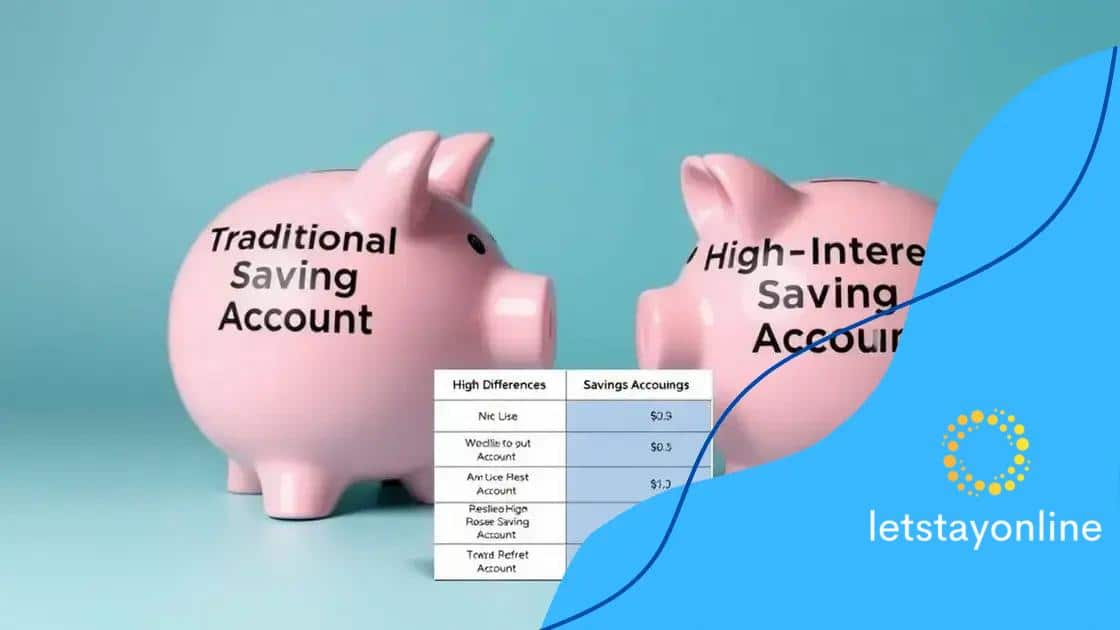High-interest savings accounts: are they worth it?

High-interest savings accounts offer higher interest rates compared to traditional accounts, allowing your savings to grow faster while providing security and easy access to funds.
High-interest savings accounts are becoming a popular choice for many looking to grow their savings. Have you wondered if they’re worth it? Let’s dive into the details together.
Understanding high-interest savings accounts
Understanding high-interest savings accounts is essential for anyone looking to grow their savings effectively. These accounts are designed to yield more interest than traditional savings accounts, helping you earn money while keeping your funds safe.
Many people ask how these accounts differ from regular savings. The main difference lies in the interest rates offered. High-interest savings accounts typically provide rates that are significantly higher, which can lead to increased returns over time. This can be particularly beneficial if you plan to save for specific goals, like a vacation or a new car.
Key Features
When considering a high-interest savings account, it’s important to look at a few key features:
- Interest Rates: These accounts often have variable rates that can change over time.
- Fees: Some accounts may charge monthly maintenance fees, which can eat into your savings.
- Accessibility: Check how easily you can withdraw funds when needed.
- Minimum Balance: Many accounts require a minimum balance to earn the highest interest.
Moreover, it’s crucial to understand the potential for compounding interest. This means that the interest you earn can generate additional interest over time. As you deposit funds into a high-interest savings account, your money can continue to grow more rapidly compared to traditional savings options.
Risk and Security
Another appealing aspect of high-interest savings accounts is their safety. Unlike investments in the stock market, these accounts are generally insured up to a certain limit by the Federal Deposit Insurance Corporation (FDIC). This insurance protects your money in case the bank fails, providing peace of mind while you save.
In conclusion, understanding the dynamics of high-interest savings accounts can empower you to make smarter financial decisions. These accounts can significantly help you achieve your savings goals if used correctly.
Key benefits of high-interest savings accounts

When considering saving options, understanding the key benefits of high-interest savings accounts is crucial. These accounts can provide your savings with the extra boost they need to grow faster.
One of the main advantages is the higher interest rates. Unlike traditional savings accounts, high-interest accounts yield more on your deposits. This means your money works harder for you, making it ideal for saving towards financial goals.
Compound Interest
Another benefit is the power of compound interest. The interest you earn can start to generate even more interest, which can drastically increase your overall savings. Over time, compound interest can significantly enhance your financial growth.
- Faster savings growth compared to standard accounts
- The effect of compound interest can lead to substantial gains
- Consistency in deposits can maximize returns
Additionally, many high-interest savings accounts offer flexibility in accessing your funds. You can make withdrawals when you need, but it’s wise to leave your money untouched to maximize your interest accrual.
Low Risk and High Security
High-interest savings accounts are typically low-risk investments. They are usually insured up to $250,000 by the FDIC, safeguarding your deposits against bank failures. This security aspect allows you to focus on growing your savings without worrying about losing money.
Moreover, these accounts can help you establish a healthy savings habit. Setting aside money in a high-interest account encourages you to save regularly, which builds financial discipline over time. Think of it as giving your finances the best chance to flourish by taking advantage of these accounts.
How to choose the right account for you
Choosing the right high-interest savings account can feel overwhelming, but it doesn’t have to be. Understanding your needs and priorities is the first step in finding the best account for you.
Start by comparing the interest rates offered by different banks. Some accounts may advertise high rates, but those rates can drop quickly, so it’s vital to look at the annual percentage yield (APY). The higher the APY, the more your savings can grow over time. Also, consider the terms of the rate. Will it stay competitive or is it an introductory rate?
Consider Fees and Minimum Balances
It’s also essential to look for any monthly fees tied to the account. Some banks offer high interest but charge a monthly maintenance fee that can offset your earnings. A good account should ideally have no fees or charges that eat into your savings.
- Monthly maintenance fees: Look for accounts with no or low fees.
- Minimum balance requirements: Ensure you can easily maintain any necessary balance.
- Withdrawal limits: Know how many times you can access your money each month.
Once you’ve narrowed down the options based on interest rates and fees, think about accessibility. You want an account that allows you easy access to your funds when necessary, while still encouraging you to save.
Research Online vs. Traditional Banks
Another factor to consider is whether to choose an online bank or a traditional brick-and-mortar bank. Online banks typically offer higher interest rates because of lower overhead costs. However, if you value face-to-face interactions, a traditional bank might be more suitable.
Lastly, check the bank’s reputation and customer service. A bank with solid customer support can make a huge difference, particularly if you have questions or issues with your account. Reviews and ratings can provide insights into what other customers have experienced.
Comparing traditional vs. high-interest accounts

Comparing traditional savings accounts with high-interest savings accounts is vital for making informed financial decisions. Both types serve the purpose of saving money, but they differ in terms of benefits and features.
One significant distinction is the interest rates. While traditional accounts generally offer lower rates, high-interest accounts provide a better opportunity for your savings to grow. This difference can have a big impact on your overall savings. Over time, the extra earnings from high-interest accounts can really add up.
Accessibility and Fees
Another aspect to consider is accessibility. Traditional savings accounts often allow easier access to funds, with fewer restrictions on withdrawals. This can be important for individuals who might need cash on short notice. However, some high-interest accounts may limit the number of withdrawals per month. Understanding the terms for each type of account can help you choose based on your financial needs.
- Traditional accounts typically have no withdrawal limits.
- High-interest accounts may offer fewer access options but better growth.
- Compare any monthly fees associated with each account type.
It’s also worth noting that most traditional savings accounts come without monthly maintenance fees, whereas high-interest accounts might charge one if a minimum balance is not maintained. Evaluating these details can help you avoid extra costs that reduce your savings growth.
Suitability for Goals
When choosing between these options, consider your financial goals. If you plan to save for emergencies and require easy access to funds, a traditional account may be best. But if your focus is on growing your savings for long-term goals like retirement or a major purchase, a high-interest account is likely more suitable.
In summary, understanding the differences between traditional savings accounts and high-interest savings accounts will guide you in making the best choice for your financial future.
Tips for maximizing your savings
Maximizing your savings in a high-interest savings account is an essential part of achieving your financial goals. By following some simple tips, you can ensure your money works harder for you.
One effective strategy is to automate your savings. Set up a direct deposit from your paycheck into your savings account. This makes saving easy and consistent, helping you grow your funds without even thinking about it.
Take Advantage of High Rates
Be sure to take full advantage of the high-interest rates offered. If your account has a variable rate, monitor it regularly to see if there are better options available. Moving your money to an account with a higher APY can lead to greater returns.
- Regularly compare rates from different banks.
- Consider switching accounts if a better rate becomes available.
- Look for promotional rates that can boost your returns.
Another important tip is to avoid withdrawals. Each time you take money out, you miss the chance to earn more interest. The longer your money stays in the account, the more interest it can accumulate. Put your money in and keep it there as long as possible.
Regular Contributions and Budgeting
Focus on making regular contributions to your savings. Setting a monthly budget can help you identify areas where you can cut back on spending and allocate more towards your savings. This consistent effort adds up over time, allowing you to reach your financial goals.
Finally, consider reviewing your financial goals periodically. This helps you assess how much you need to save and allows you to adjust your contributions and strategies accordingly. Staying informed about your financial situation will empower you to make better decisions.
FAQ – Frequently Asked Questions about High-Interest Savings Accounts
What is a high-interest savings account?
A high-interest savings account is a type of bank account that offers a higher interest rate compared to traditional savings accounts, helping you earn more on your savings.
How can I maximize my savings in a high-interest account?
You can maximize your savings by automating deposits, avoiding withdrawals, and regularly monitoring interest rates to ensure you are getting the best returns.
Are there any fees associated with high-interest savings accounts?
Some high-interest savings accounts may have fees or minimum balance requirements, so it’s essential to review the terms before opening an account.
Why should I consider a high-interest savings account over a traditional one?
High-interest savings accounts typically offer significantly higher interest rates, which can help you grow your savings faster compared to traditional savings accounts.






